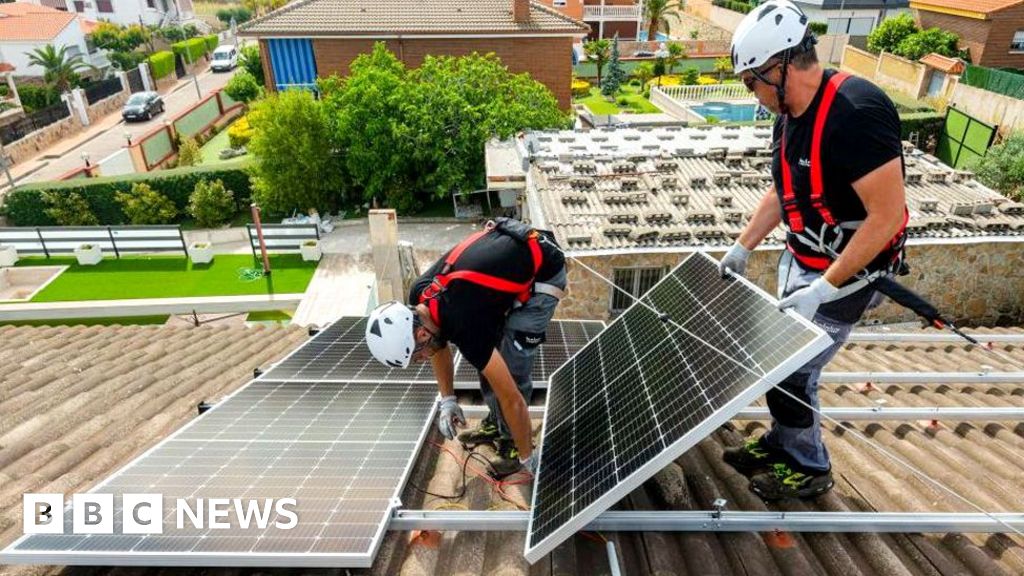The patchwork plains of Castilla-La Mancha, in central Spain, were once known for their windmills.
But now it is wind turbines, their modern-day equivalent, which are much more visible on the region’s skyline.
The 28 vast turbines of the Sierra del Romeral windfarm, perched on hills not far from the historic city of Toledo, look out over this landscape.
Operated by Spanish firm Iberdrola, they are part of a trend that has accelerated Spain’s renewable energy output over the past half-decade, making the country a major presence in the industry.
Spain’s total wind generation capacity, its prime renewable source in recent years, has doubled since 2008. Solar energy capacity, meanwhile, has increased by a factor of eight over the same period.
This makes Spain the EU member state with the second-largest renewable energy infrastructure, after Sweden in first place.
Earlier this year, Spain’s Socialist Workers’ Party prime minister, Pedro Sánchez, described his country as “a driving force of the energy transition on a global scale”.
The boom began soon after the arrival of a new government under Mr Sánchez in 2018, with the removal of regulatory obstacles, and the introduction of subsidies for renewable installation. The pandemic further accelerated the trend on a domestic level.
“The impact of Covid was very positive for our sector,” says José Donoso, chief executive of UNEF, the Spanish Photovoltaic Association, which represents the solar panel sector. “People saved money, took time to think about what to do with it, and many of them decided that it was better invested on their roof than in their bank.”
Meanwhile, the government introduced ambitious new targets, including covering 81% of Spain’s electricity needs with renewables by 2030.
However, behind this success story, there are concerns within the electricity industry caused by an imbalance between supply and demand with, at times, a surplus of electricity.
Even though the Spanish economy has bounced back strongly from the trauma of the Covid pandemic, and is growing faster than all of the bloc’s other big economies, electricity consumption has been dropping in recent years.
Last year, demand for electricity was even below that seen in the pandemic year 2020, and the lowest since 2003.
“What we saw until 2005 was that when GDP increased, demand for electricity increased more than GDP,” says Miguel de la Torre Rodríguez, head of system development at Red Eléctrica (REE), the company that operates Spain’s national grid.
More recently, he says, “we’ve seen that demand has increased less than GDP. What we’re seeing is a decoupling of energy intensity from the economy”.
There are several reasons for the recent drop in demand. They include the energy crisis triggered by Russia’s invasion of Ukraine in 2022, which caused businesses and homes across Europe to cut back on usage.
Also, energy efficiency has improved and become more commonplace.
The increased usage of renewable energy has also contributed to the reduction in demand for electricity from the national grid.
Mr Rodríguez says that during daylight hours, when solar energy output is particularly strong, the supply-demand balance can be pushed out of kilter, having an impact on prices.
“Since the power system always has to have an equilibrium – demand has to equal generation – that has meant there has been excess generation during those hours,” he says.
“That has driven prices down, especially during certain hours, when the prices have been zero or even negative.”
While such low prices are welcome for consumers, they are potentially a problem when it comes to attracting investment to the industry.
“This can make it more difficult for investors to increase their investment in new electricity based on renewable energies,” says Sara Pizzinato, a renewable energy expert at Greenpeace Spain.
“That can be a bottleneck for the energy transition.”
Concerns about Spain having an excess of electricity have led to discussion of the need to accelerate the “electrification” of the economy, which involves moving it away from fossil fuels. The Sánchez government has set a target of making 34% of the economy reliant on electricity by 2030.
“This process is going slowly, and we need to accelerate it,” says UNEF’s José Donoso.
"Electricity is the cheapest and most competitive way to produce clean energy.
“We need facilities that use electricity in place of fossil fuels.”
Shifting to a total reliance on electricity is seen as unrealistic, as some important sectors like chemicals and metals will find the transition difficult.
However, Mr Donoso and others see plenty of scope for swifter electrification. For example, Spain is trailing many of its European neighbours when it comes to the installation of heat pumps in homes, and the use of electric cars, which only make up around 6% of vehicles on the road.
Ms Pizzinato agrees that electrification is crucial, but says there are other ways of tackling the supply-demand quandary, including phasing out the use of nuclear plants more quickly, and increasing energy storage capability.
She says: “We need to engage more people and more industries in demand-side management, to make sure the flexibility needed in the system is out there to make generation and demand match better during the day and during the night.”
Amazing how such a positive thing can be written in such a dubious, not positive way! Green energy, more home efficiency, surplus of energy, not dependent from russian gas -> meh
The article: “Oh no! The excess solar production during peak hours might discourage investors from putting solar panels!”
Anyone with a brain: “why don’t we fucking skip the investors and instead invest publicly in solar if it’s so goddamn cheap?!”
Or, even if it’s inefficient, let’s start investing in grid scale storage!
Won’t someone think of the investors?!
Yup, I hated that “Too much of a good thing durr hurr” phrase in this context.
The days where the BBC had any sort of editorial independence are long gone.
Desalination of sea water. Keep our wells full by pulling from the ocean with this free energy
Spain does actually have a growing issue with water scarcity, so this should absolutely be on the table.
Yup, and hydrogen for the greenification of steel production. Pump water into elevated reservoirs as energy storage.
Plenty of good things to do with excess power.
All the places to build new hydro storage have been taken.
Are you making that up?
No. It’s pretty much accurate. Pumped hydro will always be a niche solution simply because there are not that many places where it’s possible to build.
Aw shucks. Sucks.
Are there any articles out there I could read more about this?
Not an article, but look at this graph:
https://www.statista.com/statistics/799341/global-hydropower-installation-cost/
The cost of hydro keeps going up because all the good places are taken, therefore we have to use less efficient (more expensive) locations.
Not all gravity storage is hydro though. I’ve seen “batteries” that just elevate a block on concrete and then let it fall to gather its energy. That doesn’t need a good location, like hydro. But my guess is that is even more expensive, otherwise everyone would be doing it.
Its only a problem because we dont yet have a solution to it. In realitty this is a really good thing! We just need a way to store or make use of the excess energy
I’d argue it’s not even that we don’t have a solution.
It’s we need to implement the solution. There’s absolutely tonnes to energy storage solutions ( batteries, storing it as heat, storing it as potential energy) that would work well on grid scale, just need to have their implementation catch up with generation capacity.
True! Also once storage becomes feasible, turbine prices will soar! So i guess making more than we need now, is a good investment (assuming lobbying does not get in the way of energy storing)
Don’t forget charging electric vehicles.
The existing solution isn’t economical, mostly due to grid costs. If you want it, it’ll have to come from the tax payers pocket, which means it has to compete with stuff like healthcare.
I think if the issues with russian gas have shown us anything it’s that energy security should be treated as being much more important than it has in the past. So maybe it should come from tax payers money and be thought of as part of a broad national defence strategy.
Cool to see this come up! I recently had to write a (mock) proposal regarding different efforts to store excess green energy and I had a blast reading about gravity batteries and pumped hydro. Hopefully, these projects come along sooner than later, as widespread adoption will take much longer than the first several implementations.
Another neat tidbit I learned while researching pumped hydro is that hydroelectric dams actually use the remaining inertia of the spinning generators to pump water back up the dams, which is much like the idea of regenerative braking in EVs.
Another neat tidbit I learned while researching pumped hydro is that hydroelectric dams actually use the remaining inertia of the spinning generators to pump water back up the dams, which is much like the idea of regenerative braking in EVs
Some of them. Others, like the Kidston one use solar.
When I was first learning about this stuff, I (very incorrectly) thought that the purpose of the battery was to generate (rather than store) energy, so I had a hard time wrapping my head around how they could actually work. The idea, however, is that you have your main source of green energy, and when the grid can’t take more energy, you use the excess to pump the water or lift the weight. Then, when the grid needs power you release your weight/water. In this regard, it builds capacity and stability of a green grid.
Raise 10 metric tonnes, 10m stores 2.7kWh
A model S battery is equivalent to raising 18 model S’s to the height of 10m
I don’t follow
A gravity battery doesn’t have such great energy density so you’d better be able to make it huge instead.
This is why pumped hydro is a lot better. 250 Mw from Kidston is nothing to sneeze at. Gravity works in mining situations. The one I linked to stores enough to power 1000 homes for a year
So, dig deeper with machines powered with the excess energy. I don’t see the issue…
(I’m half-joking.)
I was just translating an ancestor message, so whatever 🤷🏼♂️
No biggie, friend.
Or even turning old coal powered plants into thermal battery generators that get heated up with green electricity then generate their own through steam
Yeah, we can use whatever as long as it holds the energy without loss. A suspended load has zero loss - so does a bunch of water behind a dam.
I don’t see how thermal could do that though.
They use graphite and it’s not perfect but being able to repurpose something can be a lot more environmentally friendly plus it wouldn’t be a huge change for people who maintain thier turbines
Zero loss is not necessary in practice. Those coal plant upgrade kits use graphite blocks with embedded pipes and heating elements wrapped in absolutely bonkers isolation, all in a shipping container. Produce 700C steam. Self-discharge comparable to chemical batteries.
If you want scalable zero-loss storage because you want to store energy on a seasonal scale, or for long-distance transportation, the best solution should be to eat some conversion loss in the beginning. Ammonia, ethanol, suchlike, it’d be nice to have something that’s not toxic but, well.
Oh: Zinc. People have been trying to make rechargeable zinc batteries for ages but it’s just hard but there’s another solution: Forego the recharging part and just throw the resultant zinc oxide back into an industrial refinery process. Works with pretty much any metal but zinc is convenient and we already have tons of infrastructure. To make the stuff zero-loss simply make sure to keep the zinc away from oxygen… which is easy as zinc oxide forms a protective coat so even though it oxidises quite quickly it also quickly stops doing that. Just like aluminium.
Hot thing loses heat, re-heat it with the excess energy!
Hear me out: Automatic paella making machines.
Water pump reservoirs?
I had this discussion about a similar issue here in Denmark. The country is very
fastflat so gravity is not really an option. In Spain though id expect this should be a really good option!I’m no hydro specialist but my understanding is that in the Alps/Pyrénées, the hydro capacity is essentially maxed out because any additional projects will be denied on environmental grounds (flooding valleys is, as it turns out, not amazing for the environment). Maybe there’s some pairs of existing artificial lakes that could act as batteries, IDK. But I wouldn’t expect this to magically solve every issue.
In Belgium we have one such installation thanks to a fortuitous topological quirk, but no plans for more. Still, 10 GWh is not nothing and already helping a lot to absorb renewable fluctuations.
Ok hear me out here then. Instead of gravity storange we wind big balloons down into the ocean and let them slowly rise to the surface unwinding a generator.
But maybe pressure will crush them.
Can we maybe just compress air and generate energy while releasing the pressure?
Anything to do with seawater needs to deal with corrosion (e.g. offshore wind/tide generation). Also intuition tells me the balloons would be waaay bigger than reasonable.
Compressed air I assume is possible, as are many many other things (gravity, heat, springs, etc.). The question is which is cheaper and grid-scale; a 1 GWh pressure vessel would certainly be a sight to behold.
Also I’d personally rather live next to a wind turbine than a 1 GWh pressure vessel!
But imagine the fart sound it could make when you release it!
We could, like, dude, dude!, we could turn the earth into a flywheel.
What do you mean it is fast?
I guess it was supposed to be “flat” and autocorrect got in the way.
Thanks; I’m just waking up so it didn’t click
I assume they meant flat?
What about huge underground reservoirs?
The whole of Jutland is basically one big aquifer. The good news is that Sweden and Norway are nearby, there’s already plenty of HVDC capacity to send Danish and Schleswig-Holstein wind into their hydro storage. Which is also the bad news the capacity is basically tapped out.
There are lots of other potential (ha!) solutions for mechanical energy storage, like this one, which uses specially constructed towers to lift heavy weights.
Lots of other interesting options listed on that wiki article as well!
I can’t see why new buildings can’t function in a similar way as these gravitational blocks. Or even whole housing blocks on poles. It should be feasible. Maybe not economical yet
No problem: French nuclear reactors need to lower output in hot summers anyway because that shit relies on river water to be cold enough for cooling. Then they buy electricity from neighboring countries.
Apparently, France has historically dragged their feet when it comes to letting the Iberian peninsula connect their grid to the rest of Europe.
Which is an absolute shame, because the region should be a gigantic asset to Europe’s renewable energy supply.
Map of solar power productivity depending on hours of sunlight: https://www.hotspotenergy.com/DC-air-conditioner/Solar-Map-Europe.png
Non non non! Oh mondieu! The Spanish have le cheap green electricity! We have to prevent them to make our expensive state funded nuclear garbage obsolete or our nuclear companies cannot launder more tax money! Sacrebleu!
It’s called energy dumping and it’s not a good thing for the stability of neither the grid nor grid prices.
Unfortunately, “hot” and “sunny” do not fully overlap.
It doesn’t “rely” on that. Regulations prevent water being backfed to the river at too much of a warm temperature. And btw France were by far Europe’s biggest energy exporter in 2023
Regulations prevent water being backfed to the river at too much of a warm temperature.
Of course, because it would kill the entire river ecosystem otherwise.
It’s so cool that only NPPs feeding warm water into the river is a grave danger while regulations for other types of thermoelectric plants are much more relaxed… But you guys keep your hard on please ;)
Warm water from geothermal plants isn’t dumped into rivers. It’s pumped back underground to boil and heat the turbines again.
How much energy do geothermal plants produce in Europe lmao
You guys are delusional
How much energy do geothermal plants produce in Europe lmao
How is that related to your statement “feeding warm water into the river is a grave danger while regulations for other types of thermoelectric plants are much more relaxed”?
Not at all? You’re trying to move goalposts because your argument was insane? Good.
You guys are delusional
You’re a pro nuclear propagandist.
So you think thermoelectric plants are only geothermal plants and then hope I take you seriously lol
It doesn’t “rely” on that.
France doesn’t rely on river water to cool power plants?
Where does the water come from then?The premise is that river water isn’t cool enough to cool down NPPs. Which is false.
Ah, I see.
So the water is not too warm for cooling, it’s too warm to absorb the backfeed, which is a necessary result of the cooling process.
Which effectively still means that they can’t properly cool the plant because the river water is too warm.It’s a type of overregulation.
For having such a surplus of energy, they sure don’t fucking make it cheap! It’s their prices that discourage citizens on using the electricity…
Better than the alternative, over here it’s so cheap that people waste it and the government wants to increase production instead of forcing us to be responsible. There’s about 25 TWh we could save and instead we’re investing to produce an extra 10 TWh from wind turbines… At least we’re already 100% green, but still…
I’m sorry, but private companies price gouging it and getting record profits will never be better than the alternative you are proposing.
If it was actually cheap the tax would increase, simple as that. The government had to reduce the tax to compensate for the rpice during covid and the fucking companies raised the price so much that we ended up with higher prices than before, post tax.
Your alternative sounds great…
Sure, utilities need to be nationalized (like they are here), it’s still ridiculous that we’re flooding land by building hydro dams so we can be the place where we have the most private pools per capita or people can run their AC 24/7 even if it’s 20° outside… Instead we should be working towards getting people to reduce their energy usage.
I agree in principle but as always, it’s super unfair to place the main blame on normal citizens when there’s companies spending way, way more than citizens ever will, and those companies prefer to spend money bribing politicians so that their excessive electricity usage is ignored instead of investing in alternative ways of managing their needs.
I don’t have numbers to back my statement right now but I don’t think they are necessary.
I do agree that there are plenty people that waste the resources given to them, but they are not a majority and and I usually just complain to them directly, generalising about them before the actual major factors only pits us against each other.
The 25 TWh includes waste by companies as well but over here the biggest commercial users generate their own electricity. Still doesn’t explain why hotels and offices just leave lights on at night… Or why people leave lights turned on in rooms they’re not in in the middle of summer while they’re trying to cool their house using AC! My province is the world leader in private pools (they use a shit ton of electricity in a cold climate, 70% of electricity needs on average for houses that have one) at twice the US average (the leading country)…
Instead we should be working towards getting people to reduce their energy usage.
But in you scenario, why?
Because creating more infrastructure to generate more energy is a waste of resources and still pollutes a whole lot even if it’s “green energy”?
What do you think happens with the ecosystem behind a dam? See these lakes? Look at the scale at the bottom of the map to give you an idea how big they are. Well, they’re not lakes, they’re reservoirs, land that was flooded because a couple of rivers now have seven dams on them.

Same for solar panels and wind turbines, the resources necessary to build them didn’t come from nowhere, it comes from huge mines that destroy the land they’re on.
We’re wasting the equivalent of Slovakia’s annual electricity usage and instead of pushing people to start being responsible our government will just force the State corporation to increase its capacity.
What’s funny is that if we were talking about the quantity of petrol that we use no one would question the fact that it’s stupid to not push people to stop wasting it…
What’s funny is that if we were talking about the quantity of petrol that we use no one would question the fact that it’s stupid to not push people to stop wasting it…
This is a false equivalency, because petrol is a limited resource. Renewable energy isn’t (by its own definition.)
But I do see the validity of your other points.
It’s a limited resource as well because the infrastructure is built using limited resources, the energy that gets transformed into electricity might be limitless, but you can’t transform it once you can’t built the infrastructure anymore.
We just act like it’s not the case at the moment the same way we acted like petrol would never run out 100 years ago.
“We produce so much energy that we can use it in any way we want.”
I don’t see the problem with that.
A waste is a waste is a waste, all energy production comes with an environmental cost. While we’re wasting green energy our neighbors use dirty energy, if we stopped wasting 25 TWh we could sell the surplus to our neighbors so they reduce their carbon footprint OR we simply could have went without wasting earth’s resources to create the infrastructure necessary to generate that 25 TWh.
Good points. Giving the surplus to folks who otherwise produce their energy with carbon sounds sensible.
What’s the consumer price for electricity in Spain?
Too high, it’s generally advised to avoid using electricity when possiblenand a lot of people are on special plans where it’s cheaper on specific hours to save more money.
To have the gall to complain when the electrical company had tons of profits with the price gouging they did during covid, where the government tried to lower it by reducing the tax, and the companies raised it way more to make it even more expensive then before. There’s few industries that I hate more than the electricity industry in Spain.
What are the prices for private solar plants? For Germany’s electricity prices and current retail prices, PV and battery will pay for itself after around 6-8 years.
That’s why the EU is starting to raise tolls on Chinese PV systems.
High, but lower than the average in the EU
EU, just connect the internal energy market, so that we could accelerate the rate of phasing out the fossil power plants.
eu can export its excess energy to each other. wasnt this is the case even before green energy? why its written in such bad way.
if other comments are any indication, the gov should lower electricity cost to increase demand
Transport grids aren’t free, and excess electricity production is bad as it requires curtailment (wastage) which isn’t free either to prevent damage to electric equipment (very expensive).
Besides, when renewables produce these excesses, this will often be the case in a very large area.
Go Spain! Good work.
I thought this might be one good way to deal with it: https://youtu.be/DSQ0i4b-5ug?si=g2LLwxuRtk1t9XFf (repurposing old coal plants for storage)
This is the best summary I could come up with:
The patchwork plains of Castilla-La Mancha, in central Spain, were once known for their windmills.But now it is wind turbines, their modern-day equivalent, which are much more visible on the region’s skyline.The 28 vast turbines of the Sierra del Romeral windfarm, perched on hills not far from the historic city of Toledo, look out over this landscape.Operated by Spanish firm Iberdrola, they are part of a trend that has accelerated Spain’s renewable energy output over the past half-decade, making the country a major presence in the industry.Spain’s total wind generation capacity, its prime renewable source in recent years, has doubled since 2008.
Earlier this year, Spain’s Socialist Workers’ Party prime minister, Pedro Sánchez, described his country as “a driving force of the energy transition on a global scale”.The boom began soon after the arrival of a new government under Mr Sánchez in 2018, with the removal of regulatory obstacles, and the introduction of subsidies for renewable installation.
"Meanwhile, the government introduced ambitious new targets, including covering 81% of Spain’s electricity needs with renewables by 2030.
"Concerns about Spain having an excess of electricity have led to discussion of the need to accelerate the “electrification” of the economy, which involves moving it away from fossil fuels.
Shifting to a total reliance on electricity is seen as unrealistic, as some important sectors like chemicals and metals will find the transition difficult.However, Mr Donoso and others see plenty of scope for swifter electrification.
For example, Spain is trailing many of its European neighbours when it comes to the installation of heat pumps in homes, and the use of electric cars, which only make up around 6% of vehicles on the road.Ms Pizzinato agrees that electrification is crucial, but says there are other ways of tackling the supply-demand quandary, including phasing out the use of nuclear plants more quickly, and increasing energy storage capability.She says: “We need to engage more people and more industries in demand-side management, to make sure the flexibility needed in the system is out there to make generation and demand match better during the day and during the night.”
The original article contains 877 words, the summary contains 349 words. Saved 60%. I’m a bot and I’m open source!
I can’t believe people in the comments are so ignorant and gullible LOL
Maybe study more in depth how the electricity grid and the public incentive system works and them come back with a more informed and less populist opinion
Huge concentration of people who have no idea of how the energy grid works.
@0x815 well, if only there was a green deal or something forcing people to buy EVs to consume the extra energy… Oh, wait.











